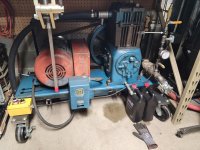Just a Sparky
Hot Rolled
- Joined
- May 2, 2020
- Location
- Minnesota
Brainstorming some ideas for constructing a poor man's compressed air dryer and aftercooler. One of the ideas which has stuck so far is buying a used plate-type heat exchanger on the cheap. Garden hose to supply naturally chilled water, compressed air in on one side, water trap on the other and voila: No more hot, wet air spitting out of my sand blaster after things warm up and less water getting into my air tank.
Only difficulty for me is determining how big of an exchanger I need for this job. Used parts are readily available from 12x5" 50-plate Kleenex-box sized stacks weighing 10 pounds to 24x7.5" 120-plate behemoths weighing over 100 pounds for reasonable prices. I've got a 10 horse single stage pump that moves about 35 ACFM. Figuring roughly 70% efficiency, that comes out to about 2.2 kW of waste heat being put into the discharge air stream which will have to be removed rapidly by the heat exchanger.
I don't have much experience with refrigeration systems. Could someone here offer some input on whether, say, a typical 12x5", 100-plate unit would offer adequate performance for this task? Or whether it would be too big/small? Looking at approximately 50-55*F water flowing at around 1/2 to 1/4 gallon per minute for a 10-20*F rise to room temperature if my math is correct. Guessing the pump discharges somewhere between 250~300*F. Just not sure how to work out my "approach" figure for various different sized stacks.
With a 1" hose feeding the stack, air will be jetting into it at around 80 miles per hour so I want to make sure whatever I hypothetically buy is going to have sufficient surface area for the task and not end up being pathetically undersized... nor an excessive waste of cash.
Only difficulty for me is determining how big of an exchanger I need for this job. Used parts are readily available from 12x5" 50-plate Kleenex-box sized stacks weighing 10 pounds to 24x7.5" 120-plate behemoths weighing over 100 pounds for reasonable prices. I've got a 10 horse single stage pump that moves about 35 ACFM. Figuring roughly 70% efficiency, that comes out to about 2.2 kW of waste heat being put into the discharge air stream which will have to be removed rapidly by the heat exchanger.
I don't have much experience with refrigeration systems. Could someone here offer some input on whether, say, a typical 12x5", 100-plate unit would offer adequate performance for this task? Or whether it would be too big/small? Looking at approximately 50-55*F water flowing at around 1/2 to 1/4 gallon per minute for a 10-20*F rise to room temperature if my math is correct. Guessing the pump discharges somewhere between 250~300*F. Just not sure how to work out my "approach" figure for various different sized stacks.
With a 1" hose feeding the stack, air will be jetting into it at around 80 miles per hour so I want to make sure whatever I hypothetically buy is going to have sufficient surface area for the task and not end up being pathetically undersized... nor an excessive waste of cash.
Last edited:


![s-l1600[1].jpg s-l1600[1].jpg](https://www.practicalmachinist.com/forum/data/attachments/310/310778-b9ad74545cbeef5cc3645468b7f71eeb.jpg)



